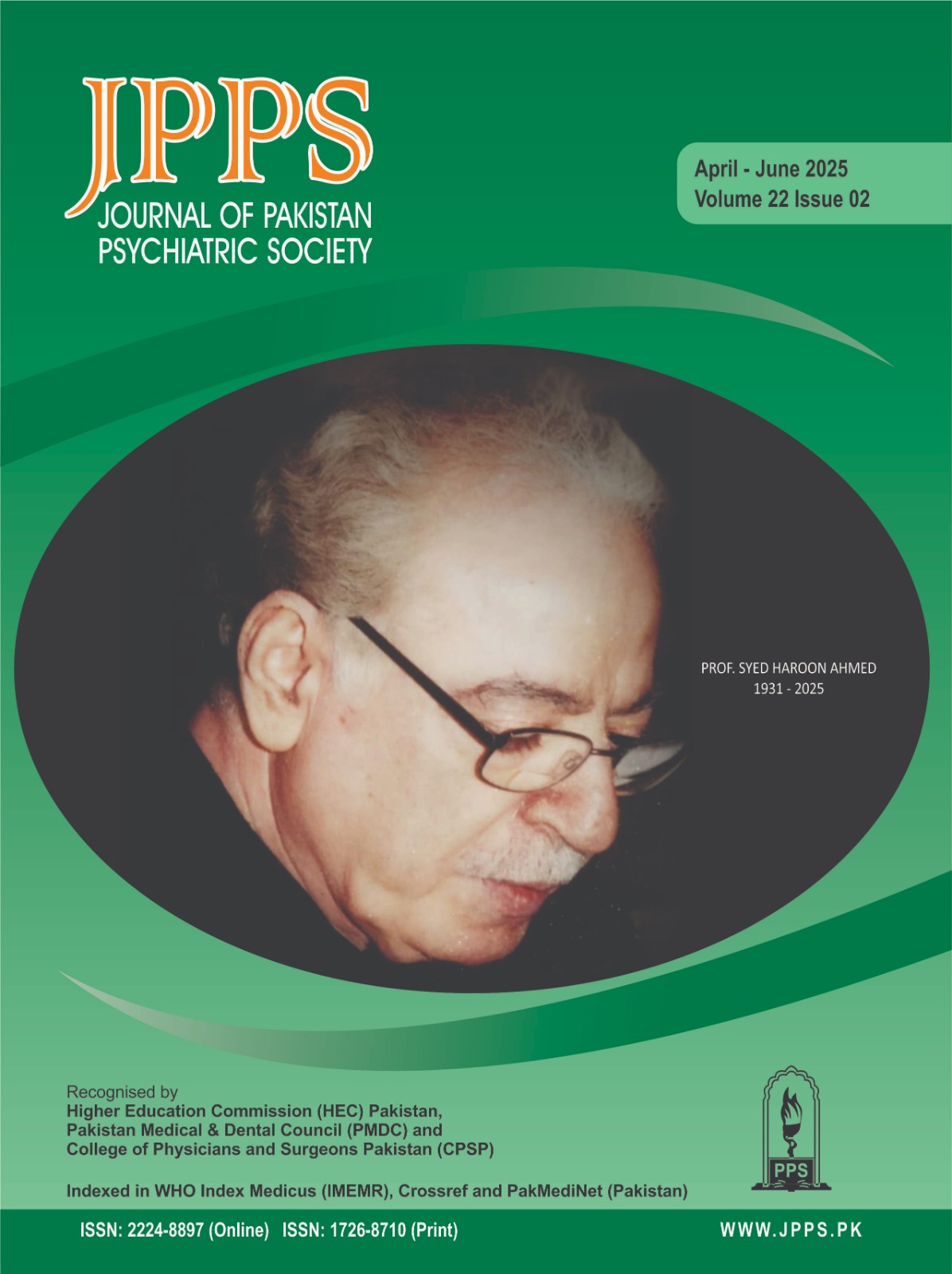SOCIO-DEMOGRAPHIC FACTORS' RELATIONSHIP WITH PSYCHOLOGICAL DISTRESS OF UNDERGRADUATE UNIVERSITY STUDENTS OF PAKISTAN
Abstract
OBJECTIVE
To investigate the relationship of socio-demographic variables (gender, peer group size) with psychological distress in undergraduate university students in Pakistan.
STUDY DESIGN
Cross-sectional study
PLACE AND DURATION OF STUDY
The study was conducted at two public and private universities in Karachi, Pakistan from June to Aug 2022.
METHOD
A total of 300 students aged 19 to 25 years completed a demographic form and the Kessler Psychological Distress Scale (K10).
RESULTS
Females reported significantly higher psychological distress than males. Students with three or more friends demonstrated lower distress compared with those reporting no friends.
CONCLUSION
Gender and peer network size were significant predictors of distress, with males and students having larger peer groups reporting lower psychological distress.
Downloads
References
Llor-Esteban B, Sánchez-Muñoz M, Ruiz-Hernández JA, Jiménez-Barbero JA. User violence towards nursing professionals in mental health services and emergency units. The European Journal of Psychology Applied to Legal Context. 2017;9(1):33–40. doi: https://doi.org/10.1016/j.ejpal.2016.06.002
Deasy C, Coughlan B, Pironom J, Jourdan D, Mannix-McNamara P. Psychological distress and coping amongst higher education students: a mixed method enquiry. PLoS One. 2014;9(12):e115193. doi:10.1371/journal.pone.0115193
Flatt AK. A Suffering Generation: Six Factors Contributing to the Mental Health Crisis in North American Higher Education. The College Quarterly. 2013; 16(1): 1-17. Available from: https://collegequarterly.ca/2013-vol16-num01-winter/flatt.html
Wahed WYA, Hassan SK. Prevalence and Associated Factors of Stress, Anxiety and Depression among Medical Fayoum University Students. Alexandria Journal of Medicine. 2017; 53(1):77-84. doi: https://doi.org/10.1016/j.ajme.2016.01.005
Hakami RM. Prevalence of Psychological Distress Among Undergraduate Students at Jazan University: A Cross-Sectional Study. Saudi J Med Med Sci. 2018;6(2):82-88. doi:10.4103/sjmms.sjmms_73_17
Amr M, Amin TT, Saddichha S, et al. Depression and Anxiety among Saudi University Students: Prevalence and Correlates. The Arab Journal of Psychiatry. 2013;24(1):1–7. doi: 10.12816/0000092
Azim SR, Baig M. Frequency and perceived causes of depression, anxiety and stress among medical students of a private medical institute in Karachi: a mixed method study. J Pak Med Assoc. 2019;69(6):840-845.
Kumar B, Shah MAA, Kumari R, Kumar A, Kumar J, Tahir A. Depression, Anxiety, and Stress Among Final-year Medical Students. Cureus. 2019;11(3):e4257. doi:10.7759/cureus.4257
Asif S, Mudassar A, Shahzad TZ, Raouf M, Pervaiz T. Frequency of depression, anxiety and stress among university students. Pak J Med Sci. 2020;36(5):971-976. doi:10.12669/pjms.36.5.1873
Idowu OM, Adaramola OG, Aderounmu BS, et al. A gender comparison of psychological distress among medical students in Nigeria during the Coronavirus pandemic: a cross-sectional survey. Afr Health Sci. 2022;22(1):541-550. doi:10.4314/ahs.v22i1.63
Siddiqui RS, Jahangir AA, Hassan A. Gender differences on perceived social support and psychological distress among university students. Global Management Journal for Academic & Corporate Studies. 2019; 9(2): 210-223.
Zahid A, Agha SA. Prevalence of Psychological Distress: Gender Differences among University and College Students and Teachers. Balochistan Review. 2019;XL(2):235-241. Available from: https://www.uob.ac.pk/Journals/BalochistanReview/data/BR%2001%202019/235-241%20Prevalence%20of%20Psychological%20Distress%20Gender%20Differences%20%20among%20University%20and%20College%20Students%20and%20Teachers,%20Arooj%20Zahid.pdf
Islam FMA. Psychological distress and its association with socio-demographic factors in a rural district in Bangladesh: A cross-sectional study. PLoS One. 2019;14(3):e0212765. Published 2019 Mar 13. doi:10.1371/journal.pone.0212765
Kidwai R. Demographic factors, social problems and material amenities as predictors of psychological distress: a cross-sectional study in Karachi, Pakistan. Soc Psychiatry Psychiatr Epidemiol. 2014;49(1):27-39. doi:10.1007/s00127-013-0692-0
Khan MN, Akhtar P, Ijaz S, Waqas A. Prevalence of Depressive Symptoms Among University Students in Pakistan: A Systematic Review and Meta-Analysis. Front Public Health. 2021;8:603357. doi:10.3389/fpubh.2020.603357
Kessler RC, Andrews G, Colpe LJ, et al. Short screening scales to monitor population prevalences and trends in non-specific psychological distress. Psychol Med. 2002;32(6):959-976. doi:10.1017/s0033291702006074
Andrews G, Slade T. Interpreting scores on the Kessler Psychological Distress Scale (K10). Aust N Z J Public Health. 2001;25(6):494-497. doi:10.1111/j.1467-842x.2001.tb00310.x
Afifi M. Gender differences in mental health. Singapore Med J. 2007;48(5):385-391.
Padrón I, Fraga I, Vieitez L, Montes C, Romero E. A Study on the Psychological Wound of COVID-19 in University Students. Front Psychol. 2021;12:589927. doi:10.3389/fpsyg.2021.589927
Cohen S, Wills TA. Stress, social support, and the buffering hypothesis. Psychol Bull. 1985;98(2):310-357.
Li L, Xu G, Zhou D, Song P, Wang Y, Bian G. Prevalences of Parental and Peer Support and Their Independent Associations With Mental Distress and Unhealthy Behaviours in 53 Countries. Int J Public Health. 2022;67:1604648. doi:10.3389/ijph.2022.1604648
Zimmerman C, Garland BH, Enzler CJ, Hergenroeder AC, Wiemann CM. The roles of quality of life and family and peer support in feelings about transition to adult care in adolescents with gastroenterology, renal, and rheumatology diseases. J Pediatr Nurs. 2022;62:193-199. doi:10.1016/j.pedn.2021.04.032
Haslam C, Jetten J, Cruwys T, Dingle GA, Haslam SA. The New Psychology of Health: Unlocking the Social Cure. 1st ed. Abingdon, Oxon: Routledge; 2018.
Copyright (c) 2025 Journal of Pakistan Psychiatric Society

This work is licensed under a Creative Commons Attribution-NonCommercial 4.0 International License.
Copyright © JPPS. Published by Pakistan Psychiatric Society
Licensing: This work is licensed under Creative Commons Attribution-NonCommercial 4.0 International License
Readers may “Share-copy and redistribute the material in any medium or format” and “Adapt-remix, transform, and build upon the material”. The readers must give appropriate credit to the source of the material and indicate if changes were made to the material. Readers may not use the material for commercial purposes. The readers may not apply legal terms or technological measures that legally restrict others from doing anything the license permits.






.png)









